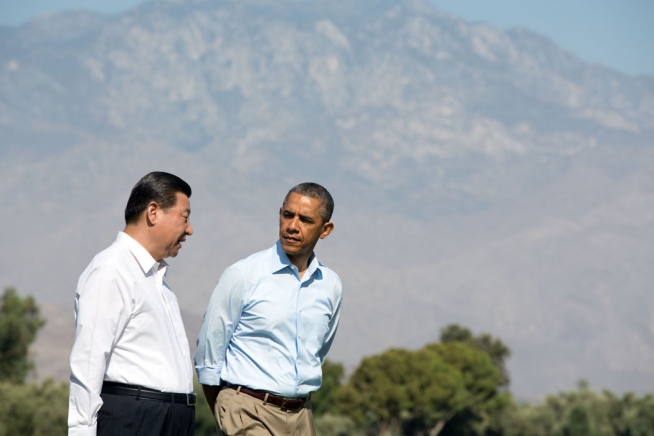
White House / Pete SouzaXi Jinping and Barack Obama, having a tie-less chat about cyberespionage and climate change.
Hydrofluorocarbons, the climate-changing twins of ozone-ruining chlorofluorocarbons, had best watch out. The world’s two most powerful countries have agreed to join forces to prevent the harmful chemicals from entering the atmosphere.
Barack Obama and Chinese President Xi Jinping spent Friday and Saturday talking in California. They couldn’t find much middle ground on cyberespionage, or on a handful of other security issues. But they agreed that their two countries will work together to tackle one of the world’s greatest climate threats.
“[N]either country by itself can deal with the challenge of climate change,” Obama said at a press conference with Xi.
The use of ozone-depleting chlorofluorocarbons (CFCs) has been sharply curtailed under the 1987 Montreal Protocol, which is one of the world’s most successful international agreements. But the protocol has led many manufacturers of fridges and other appliances to switch from CFCs over to hydrofluorocarbons (HFCs), which, while harmless to the ozone layer, are among the most potent of the greenhouse gases.
For years, environmentalists and governments, including the U.S., have been pushing the idea of expanding the Montreal Protocol to also cover HFCs to help tackle climate change. And now China and the U.S. have agreed to do what they can to make that happen. From the White House:
For the first time, the United States and China will work together and with other countries to use the expertise and institutions of the Montreal Protocol to phase down the consumption and production of hydrofluorocarbons (HFCs), among other forms of multilateral cooperation. A global phase down of HFCs could potentially reduce some 90 gigatons of CO2 equivalent by 2050, equal to roughly two years worth of current global greenhouse gas emissions.
David Doniger, policy director of the Natural Resource Defense Council’s climate program, described the White House’s announcement as “a big deal.” From his blog post:
For the past four years, support has been growing among both developed and developing countries for tackling HFCs under the Montreal Protocol. This treaty has a proven formula that combines phase-down commitments by both developed and developing countries, with the latter receiving extra time and financial assistance. Every country in the world is a party to this treaty, and together they have already eliminated more than 97 percent of the chemicals that damage the earth’s fragile ozone layer.
Despite the widespread support, progress was slowed in past years by opposition from China, India, and Brazil. But this U.S.-China agreement is a strong signal that things are about to change. There have also been signs of change from India as well.
The Europeans are also launching a big push to use the Montreal Protocol to phase out the use of HFCs. From a June 3 Bloomberg article:
International coordination to reduce hydrofluorocarbons, known as HFCs or F-gases, could have a “significant impact” on reducing emissions, said Artur Runge-Metzger, the European Commission’s lead envoy at United Nations climate talks that began today in Bonn. HFCs make up about 1 percent of greenhouse gases and may account for more than 20 percent by 2050, he said.
The EU is seeking ways to expand the global fight against climate change before 2020, when nations plan to bring a new emissions treaty into effect. The bloc is pushing to delegate HFC reductions to a different treaty, the Montreal Protocol, which was established in 1987 to eliminate chlorofluorocarbons, the so-called CFC gases found in aerosols and solvents.
“We and others believe that the best framework for implementing the phase-down is the Montreal protocol,” Runge-Metzger told reporters. “It has 25 years of experience in addressing fluorinated gases and dealing with the industry sectors that are affected.”
It’s no deal on CO2, but it’s something.



